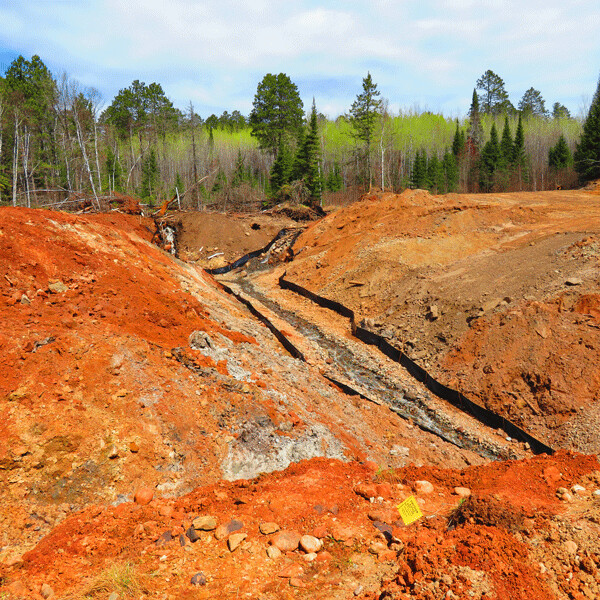News & Articles
Browse all content by date.



On April 24, water in the old Hector mine near Biwabik broke its earthen barrier, cutting a gash in the land and spilling iron oxide and sediment into the Embarrass River and lakes downstream, turning the water a day-glo reddish brown.
State agencies said the runoff does not pose a threat to human health and the main concern is how it will affect fish spawning. But the breach heightened concerns about Polymet Mining’s proposed Northmet mine.
Unlike iron ore mines like Hector, Northmet will be a “nonferrous” mine for nickel, copper and platinum-group elements, the first of its kind in Minnesota. Nickel and copper are embedded in sulfide rock that, when exposed to air and water, produces sulfuric acid. The tailings basin, where millions of tons of waste rock and sand will be deposited, could leak, or, at worst, break and release a flood of toxic sludge.
Hector and Northmet are very different in terms of site specifics and geology, said Aaron Klemz of the Minnesota Center for Environmental Advocacy. The berm that broke at Hector “was a strip of land, not meant to hold in water,” he said.
The parallel is that “this is what happens when you don’t have a plan after it closes and there’s no corporation taking care of it. They’re not well cared for,” he said.
Polymet expects its mine to be in operation for 20 years. Then it would go through a reclamation process including planting vegetation, restoring wetlands, treating affected water “for as long as needed” and “placing waste rock with a higher potential for harmful chemical reactions back into the mine pit and submerging it underwater to minimize the surface stockpile areas and potential pollution.”
The waste rock would be stored in a two-and-a-half-square-mile tailing pond with a dike building in stages up to 250 feet high and 5 miles long, in the existing tailing basin used by the former LTV iron mine. Polymet maintains the basin has been stable for decades and the company will upgrade it with a a seepage capture system, clay lining and monitoring devices.
But the tailing will remain potentially toxic for for hundreds of years, perhaps indefinitely. Polymet would be required to provide financial assurance, basically a damage deposit, to cover reclamation and long-term water treatment. Assurance does not cover catastrophe such as a dam break, which is covered by liability insurance. Critics question whether the state will require adequate assurance or insurance, and whether it can be accurately calculated over a long time period.
“No one thought the Hector mine was a problem until it was,” Klemz said. “Then everyone looks at each other and wonders how it happened. What happened at Hector pales in comparison to what could happen with Polymet.” Polymet did not return the Reader’s phone call by deadline.
In 2014 a tailings basin dam, only 18 years old, broke at the Mount Polley copper and gold mine in British Columbia. It was one of the biggest environmental disasters in modern Canadian history.
Polymet says its dam will be much more stable since the slopes of the Mount Polley dam were six times steeper and failed to account for soft sediment in the foundation. But the same company that designed the Mount Polley dam, Knight Piesold, also provided technical assistance to Polymet.
Polymet has the option to store the tailings in a dry, compacted state, but the company says it would have to be relocated to large new area, destroying green space. It would also negate an environmental benefit, recycling tailing basin water in the mine plant.
According to Polymet’s fact sheet, “Our tailings basin is one of dozens of large tailings basins found in northern Minnesota, some of which are as old as iron mining itself. None of these Iron Range tailings basins is known to have ever experienced a catastrophic dam failure.”
But there have been close calls. In 2012, Hibbing Taconite Company found a 1,000-foot crack in the dam of its tailing basin, requiring emergency repairs. The ArcelorMittal Minorca Mine near Virginia paid over $300,000 in fines for tailings spills in 2013 and 2014.
“When we consider the recorded life of tailings dams structures (a century at most) compared to the length of time that they must function (millennia), the number of failures observed in the first century of their operation is not comforting,” wrote David M. Chambers in a report to the National Forest Service. “The statistics suggest a rather severe underestimation of risk continuing even today in tailings dam permitting and construction. Our society still does not fully appreciate the long-term implications of storing billions of tons of potentially-harmful and semi-fluid waste in large impoundments.”
More information can be found at dnr.state.mn.us/polymet.
| Tweet |


